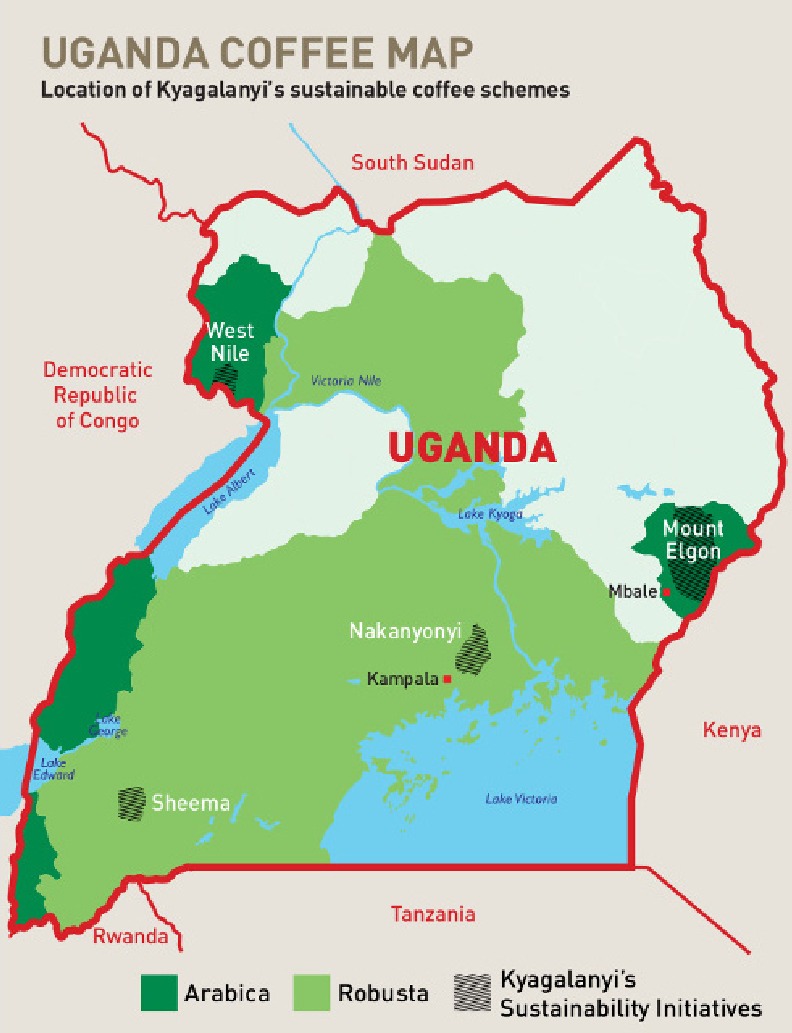
When most people think of major coffee producing countries, they don’t think of Uganda. However, coffee makes up nearly 30% of Uganda’s annual foreign trade earnings. The country actually is one of the birthplaces of Robusta coffee but has become a major producer of quality Arabicas.
Bugisu coffee from eastern Uganda is grown around Mount Elgon, an extinct volcano on the border of Kenya, and processed using the wet method. In the west, farms in the Rwenzori mountains grow and process their beans using the dry method, creating what was historically called DRUGAR, short for dried Uganda Arabica.
Robusta is still grown in the country’s central lowlands.
While much of Uganda’s coffee production yields low-grade commercial beans, small lot farmers have been recognizing their country’s advantageous coffee-growing geography and making a push to up their quality. The flavor profile varies depending on whether you try eastern washed coffee or DRUGAR, but Ugandan coffee has a smooth mouthfeel with hints of stonefruit and berries, like many African coffees.
While Uganda is a landlocked country roughly 500 miles from the Indian Ocean, it has a diverse geography with volcanic mountains stretching as high as 16,700 feet and several large lakes. The entire country is fairly elevated with the average elevation nearly 1,500 feet.
Just north of the equator between 1°N and 4°N latitudes, Uganda has a hot, equatorial climate with plenty of sunlight. The country is approximately twice the size of Pennsylvania (with nearly four times as many people) and is bordered by Tanzania and Rwanda to the south, Zaire to the west, South Sudan to the north, and Kenya to the east.

The map above shows Uganda's coffee-growing regions with the lower-lying regions primarily growing commercial-grade Robusta and more elevated regions growing Arabica.
Uganda is fortunate to have fertile farmlands and several high-elevation regions suitable for growing quality Arabicas, but their recent history of armed conflicts has slowed the industry's spread into specialty-grade coffees. Still, there are several small lot farms that can (and do) export some of the best beans in the world, and Uganda's farmers have shown a willingness and aptitude to adopt novel farming practices that are starting to bear fruit (pun intended).
There are three regions most suitable for growing high-quality, specialty-grade coffees:
Let's take a look at each.
Located on Uganda's eastern border with Kenya, Mount Elgon is the oldest volcano in Africa with coffee farms dotting its slopes. The Bugisu region on Mount Elgon's western slope is the most famous sub-region and is known for fruity, wine-like coffees with deep sweetness brightened by hints of citrus.
The West Nile region is located in Uganda's lush, rainy northwestern corner and borders the Democratic Republic of the Congo and South Sudan. Ever hear of West Nile Virus? I'm sure you have. It was first isolated in humans in 1937 in this region. Farming is life in the West Nile region, and its verdant highlands grows alluring coffees made even more complex by the washed processing method employed by local farmers.
The Rwenzori Mountains, also called Mountains of the Moon, are tall, imposing, glacier-packed peaks stretching along the Uganda's western border with the Democratic Republic of the Congo. Not only do the mountains provide the elevations required for high-quality Arabicas, but they provide plenty of water and cloud-cover with ample rainfall and glacial melt nourishing some of Uganda's most prized exports.